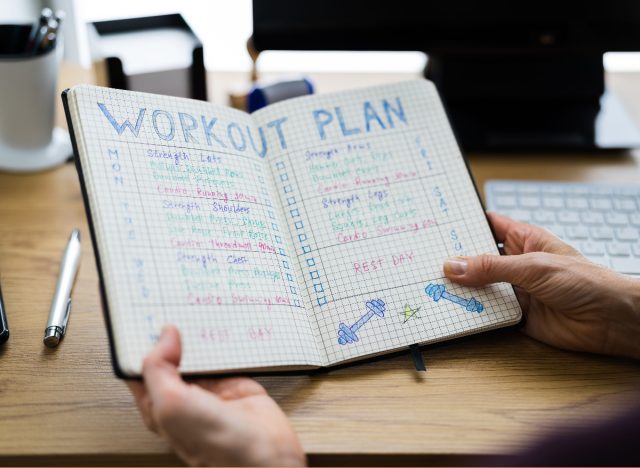Growing older doesn’t only mean pesky gray hairs shocking the heck out of you when you look in the mirror. Your body endures many changes underneath the surface—one of them being the loss of lean muscle mass, also known as sarcopenia. Staying on top of your muscle mass is the name of the game as you age. In fact, your independence and overall well-being depend on it! That’s why we’re here to share six habits to regain muscle mass after 60 with expert-backed tips.
Research shows that you can lose anywhere from 3% to 8% of muscle mass every decade after your 30th birthday. If you don’t do anything to build up and maintain muscle, sarcopenia could cause a decline in mobility. It can also make you feel weak, heightening your risk of suffering from falls, fractures, and other injuries. Needless to say, there’s no better time than the present to take action and give your daily routine a much-needed facelift.
We chatted with Maggie Priore, a personal trainer on Fyt, who walks us through the top daily habits to regain muscle mass after 60. It’s time to listen up and take some notes!
Start strength training.


Let’s get real: Strength training is king—especially when it comes to building and preserving muscle mass. Priore dubs it “the most important habit you can develop to increase muscle mass at any age.”
Performing exercises that have “progressive overload,” which means bumping up the intensity of the movement by slowly increasing the time, number of reps, or weights, helps you regain muscle mass. “Other benefits include having more energy throughout the day, added prevention of arthritis (and other ailments we are more at risk for when we get older), improved posture, and better flexibility,” Priore adds.
If you’re a newbie to strength training, work it into your fitness routine two to three times a week for 30 to 45 minutes.
Set strength training goals.


Now that we’ve established just how necessary strength training is, let’s talk about setting goals. When kicking off any health and fitness regimen, it’s essential to provide yourself with small goals. Another key tidbit? Be patient because it’s all a process!
According to Priore, “Setting too large a goal or expecting to make huge muscle gains after only a couple of weeks can lead to discouragement. It takes time to regain muscle.”
Priore suggests writing down the goals you’d like to achieve in one month, three months, and six months. Once each period ends, note what you succeeded at and what you can work on. Every time you reevaluate your progress, tweak your goals as you see fit.
Stretch it out.


Stretching helps you avoid sore muscles and injuries. It’s a necessity—not a question—to perform a solid warm-up and cool-down routine for every workout you do.
In addition, Priore explains, “On days when you aren’t strength training, spending a little time stretching will help improve posture, eliminate back pain, and improve flexibility.”
Focus on low-impact cardio.


Okay, we can’t say enough good things about strength training, but let’s not forget to show low-impact cardio some love, too. Carving out time for low-impact cardio workouts like walking, using the elliptical, swimming laps, or hiking your favorite trails is incredibly beneficial. How so? Priore says this form of exercise can aid in fat loss and toning your entire body. Low-impact cardio is a stellar choice to incorporate into any regular fitness rotation, so start pronto.
Increase your protein intake.


Bumping up the amount of protein you consume comes with many health benefits.
Priore tells us, “Not only [will it] help you regain muscle mass, but [it will] also help promote weight loss. A person trying to increase muscle mass should have .5 to .8 grams of protein per pound of body weight a day.”
Make rest a top priority.


You may not know this, but getting enough solid sleep is just as important as staying on track with a healthy diet and workout routine.
“Active adults should get at least seven hours of sleep a night,” Priore explains. “A good night’s sleep gives your muscles time to recover from workouts and other activities. When you sleep, your muscles can rebuild, and you will have better energy for your next workout.”











